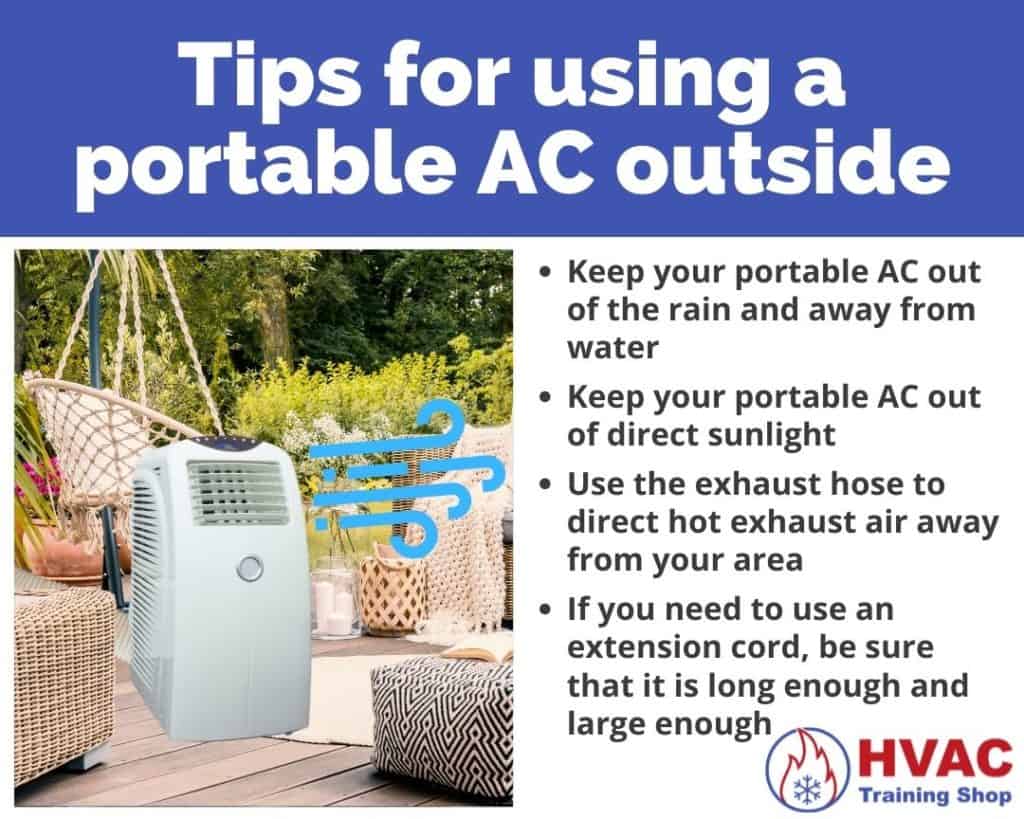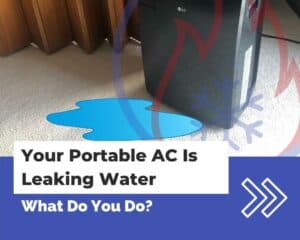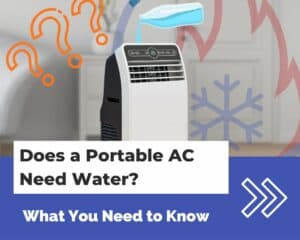HVAC Training Shop is reader-supported. As an Amazon Associate, I earn from qualifying purchases.
Summertime brings clear skies and hot temperatures. Great weather for spending some time outside—whether it be in your backyard, in a park, or at a campsite. But what do you do if you want to go outside, but it’s way too hot?
Using a portable air conditioner outside can provide relief from hot weather.
You can use a portable air conditioner outside as long as you just need a cool breeze of air. If you need to keep an outside open area at a stable temperature, then a portable AC won’t work.
In this article, I’ll go over what you need to know about using a portable AC outside—in both open areas and enclosed areas. I’ll also discuss other options for cooling outside areas, so you can make the correct choice no matter what the weather is!
What you need to know about using a portable AC outside
No matter where you use your portable AC outside, there are a few things that you need to know:
- Portable air conditioners are not waterproof, so you need to keep it out of the rain and away from water.
- Portable air conditioners have reduced efficiency when they heat up, so keep it out of direct sunlight.
- Portable air conditioners move heat from one place to another, so you still need to use the exhaust hose to direct the hot exhaust air away from your area.
- Portable air conditioners need a power source, so you may need to use an extension cord to power the AC. Be sure that the extension cord is long enough and large enough (more on this below).

There are a few things that you need to keep in mind depending on if you are using your portable AC outside in an open area or an enclosed area.
I’ll go over the specific requirements for each situation below.
How to use a portable AC outside in an open area
When using a portable AC outside in an open area, you need to remember that your space will never be able to maintain a stable temperature. The best that you can do is point your portable AC at the area you’re in to provide a breeze of cool air.
Here’s how to use your portable AC outside in an open area:
- Identify the area that you want to cool. Keep in mind that it will be a small area that will be directly cooled by the AC. For example, a small table or sitting area.
- Find a place to put your portable AC. After you identify the area that you want to cool, find the best place to put your portable AC. Your portable AC will need to be fairly close to the area you want to cool for you to feel the cooling effect. You also need to keep your portable AC out of the sun and rain.
- Find a power source. You will need a wall outlet to power your portable AC. If you’re using a generator, be sure that it can provide enough amps to power your portable AC. If you need to use an extension cord, be sure that its gauge size is sufficient to power your portable AC. See my Extension Cord Wire Gauge Requirements table below.
- Setup the portable AC. After you’re done finding a power source and a place to put your portable AC, plug the AC in. Adjust the direction of the AC so that it blows cold air on your area. You will also need to install the exhaust hose to direct the hot exhaust air away from your area.
- Turn on and test your portable AC. After everything is set up, go ahead and turn on the portable AC. Have a seat in your area to see if you can feel the cooling and make adjustments if necessary.
Keep in mind that using an AC outside is not an optimal scenario. Your portable AC won’t be able to keep a large area cool, just a small part.
Also, when using your portable AC outside in an open area it will never stop running. This is because the portable AC will never be able to keep the space at a stable temperature. It will always be hot, except for the area that the AC is directly blowing air at.
How to use a portable AC outside in an enclosed area
Using a portable AC outside in an enclosed area such as a tent or RV is a perfect application. Your main concerns will be setting up the exhaust vent and finding a power source.
Here’s how to use your portable AC outside in an enclosed area:
- Find a place to put your portable AC. For example, if you want to cool a tent, then you’ll need to find a place inside the tent to put your portable AC. I recommend putting the portable AC in a corner somewhere near a window so you can vent the exhaust house outside.
- Find a power source. Your portable AC will need a generator or wall outlet power to run. If you use a generator, be sure that it can provide enough power for your portable AC. If you need to use an extension cord, be sure that the extension cord is large enough to power your portable AC. See my Extension Cord Wire Gauge Requirements table below.
- Setup the portable AC. Plug your portable AC in and install the exhaust hose. Be sure that the exhaust hose is able to blow all of the hot air outside of your enclosed area. If the hot exhaust stays inside your enclosure, then your portable AC won’t work.
- Turn on and test your portable AC. Once your portable AC is set up, close all your doors and windows so that outside air doesn’t find its way back in. Turn on your portable AC and see if it works properly. If you are cooling a small space, then your portable AC should be able to maintain temperature inside the enclosure.
Extension Cord Wire Gauge Requirements for a Portable AC (12.5 Amps or less) | |
Extension Cord Length: | Minimum Extension Cord Wire Gauge Size: |
25' | 16 AWG |
50' | 14 AWG |
100' | 12 AWG |
150' | 10 AWG |
Other options for cooling an outside area
If a portable AC won’t meet your outdoor cooling needs, then there are other options.
Using a misting fan or an evaporative cooler may actually work better for cooling your outside area.
Both of these devices have their advantages and drawbacks, depending on the area and climate that you’re using them in.
Using a misting fan to cool your outside area
If you need to cool a large outside open area, then a misting fan is an excellent option.
Misting fans work by spraying small water droplets into the air and blowing the mist around. The effect? A cool misty breeze on a hot summer day.
In the right setting, a misting fan is a perfect solution to keep your outside area cool. I recommend using a misting fan in a grassy area such as a backyard.
The Misto misting fan has a centrifugal fan that propels mist droplets across your backyard. Perfect for keeping your family cool while playing outdoors.
The main drawback of a misting fan is that in addition to power, you also need water. Most misting fans require a hook up to a garden hose or other pressurized source of water.
Using an evaporative cooler to cool your outside area
An evaporative cooler or “swamp cooler” operates on the same principle as a misting fan. The main difference is that instead of spraying water around, the water stays inside the unit.
An evaporative cooler consists of a fan and a damp pad. As the fan blows air through the damp pad, the water inside the pad evaporates and lowers the temperature of the air.
As an evaporative cooler runs, it blows cool humid air into your space.
There are a few drawbacks to using an evaporative cooler. The main drawback is that evaporative coolers don’t work in humid climates. They work best in hot, dry climates since the air needs to be able to pick up some moisture to provide cooling.
Another drawback is that evaporative coolers increase the humidity in the air. If you use an evaporative cooler in an enclosed space, it will feel very humid and swampy after a while—hence the name “swamp cooler”.
Using an evaporative cooler to cool your outside area is an excellent option for a few reasons:
- You can cool a very large area—provided you have a large enough unit.
- Evaporative coolers use less power than portable air conditioners (as long as you’re in a dry climate).
- Evaporative coolers add moisture to the air—a desirable effect for the hot, dry climates that they are typically used in.
This evaporative cooler provides 2,400 CFM of airflow and up to 20°F of temperature drop. Perfect for keeping cool outside on those hot, dry summer days.
So if you live in a hot, dry climate and need some cooling, consider using an evaporative cooler instead of a portable air conditioner.






Evaporation cooling is not an option in Atlanta GA due to the high humidity. Some portable A/C units have one hose while others have two. Does it matter for outdoor use on a covered (not enclosed) deck?
Hi Ken,
If you’re using your portable AC outside in an unenclosed space, then it won’t matter if you use a one- or two-hose portable AC unit. Regardless of the hose type, the portable AC won’t be able to keep the entire space at a stable temperature, it will only provide a breeze of cold air.
Hope this helps,
-Trey
Hi Trey,
We are currently updating our 20×20 pool patio…new furniture, 72″ fan, larger tv, etc. and ran across your website looking for options to keep the space cooler during the hot Florida summer months. I want to get your thoughts on putting a portable a/c unit in a covered, three wall patio…opening faces the pool/patio and the other three walls are part of the house. Do you believe this will help in a semi open patio? Also, because the unit is outside and won’t cycle on and off, does this shorten its life? Any other suggestions would be appreciated.
Thanks!
Jack
Hi Jack,
A 20×20 space is very large for a portable air conditioner to keep cool, especially if one side is open. You’ll probably only feel the cool air directly in front of the portable AC.
The lifespan of the portable AC will definitely be impacted by using it outside in the Florida heat. Remember is to clean the filters. You might also want to setup a continuous drain so you don’t have to keep emptying the condensate tank.
Best of luck,
-Trey
Hey Trey, I have a good quality server room portable AC unit that I want to use to cool my van. Can I set it up outside and just pipe the cool air in. I was thinking of making a box for it to sit in while its outside.
Thanks Greg
Hi Greg,
I’m not sure about the specifics of the exact portable AC that you have. Is it the kind that has those flexible pipes that direct airflow? If so, it should be ok to pipe the airflow into your van. You may want to crack open a window in your van while the AC is running to allow the pressure to equalize. Regarding the box for the AC, make sure you don’t block the hot discharge air that gets blown out of the AC, that will cause huge problems.
-Trey